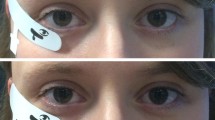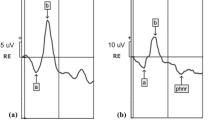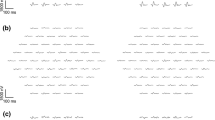Abstract
Pattern evoked potentials were recorded simultaneously with an electrode placed on the skin of the lower eyelid, gold foil electrodes hooked on the right and left eyelids, and a skin electrode at Oz in normal subjects and in patients with optic nerve and macular diseases. Peak latencies and amplitudes of the pattern electroretinogram (PERG) were compared between the two electrodes.
In both records, the peak latency showed no difference at 56.7 ± 2.9ms (mean ± S.D.), while the amplitude of the PERG with the lid skin electrode was at 1.2 ± 0.3 μV, approximately one-third of that obtained with the gold foil electrode.
Although the skin electrode did not always record responses as well as the gold foil, its advantages recommend its use in clinical cases.
Similar content being viewed by others
References
Adachi-Usami E and Chiba Y (1971) The clinical ERG detected with skin electrodes. Acta Soc Ophthalmol Jpn 75:1056–1061
Adachi-Usami E, Kuroda N and Nakajima I (1983) Distribution of pattern-evoked potentials in the facial area. Am J Ophthalmol 96:734–739
Adachi-Usami E, Murayama K and Kuroda N (1984) Pattern ERGs recorded with skin electrodes. Folia Ophthalmol Jpn 35:1528–1532
Arden GB, Carter RM, Hogg C, Siegel IM and Margolis S (1979) A gold foil electrode: extending the horizons for clinical electroretinography. Invest Ophthalmol Vis Sci 18:421–426
Arden GB, Vaegan and Hogg CR (1982) Clinical and experimental evidence that the pattern electroretinogram (PERG) is generated in more proximal retinal layers than the focal electroretinogram (FERG). Ann NY Acad Sci 388:580–601
Armington JC, Corwin TR and Marsetta R (1970) Simultaneously recorded retinal and cortical responses to patterned stimuli. J Optom Soc Am 61:1514–1521
Bloom BH and Sokol S (1979) A corneal electrode for patterned stimulus electroretinography. Am J Ophthalmol 83:272–275
Dawson WW, Trick GL and Litzkow CA (1979) Improved electrode for electroretinography. Invest Ophthalmol Vis Sci 18:988–991
Grounauer PA (1982) The new single-use ERG corneal contact lens electrode and its clinical application. In: Doc Ophthalmol Proc Series 31, 89–93
Lawwill T (1974) The bar-pattern electroretinogram for clinical evaluation of the central retina. Am J Ophthalmol 78:121–126
Riggs LA, Johnson EP and Schick AML (1964) Electrical response of the human eye to moving stimulus pattern. Science 114:567
Author information
Authors and Affiliations
Rights and permissions
About this article
Cite this article
Kakisu, Y., Mizota, A. & Adachi, E. Clinical application of the pattern electroretinogram with lid skin electrode. Doc Ophthalmol 63, 187–194 (1986). https://doi.org/10.1007/BF00157130
Issue Date:
DOI: https://doi.org/10.1007/BF00157130




